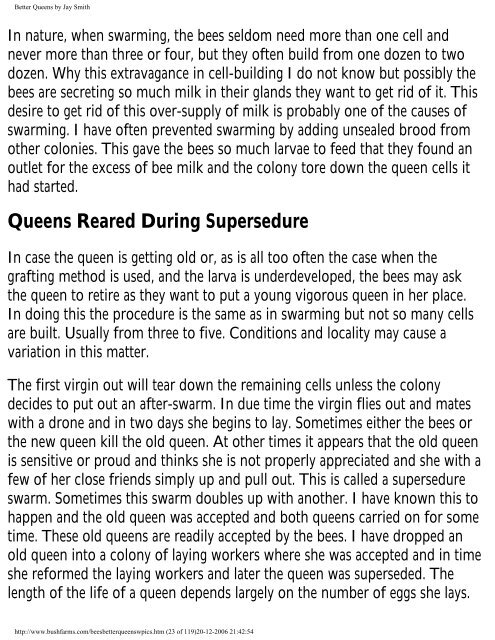You also want an ePaper? Increase the reach of your titles
YUMPU automatically turns print PDFs into web optimized ePapers that Google loves.
<strong>Better</strong> <strong>Queens</strong> <strong>by</strong> <strong>Jay</strong> <strong>Smith</strong><br />
In nature, when swarming, the bees seldom need more than one cell and<br />
never more than three or four, but they often build from one dozen to two<br />
dozen. Why this extravagance in cell-building I do not know but possibly the<br />
bees are secreting so much milk in their glands they want to get rid of it. This<br />
desire to get rid of this over-supply of milk is probably one of the causes of<br />
swarming. I have often prevented swarming <strong>by</strong> adding unsealed brood from<br />
other colonies. This gave the bees so much larvae to feed that they found an<br />
outlet for the excess of bee milk and the colony tore down the queen cells it<br />
had started.<br />
<strong>Queens</strong> Reared During Supersedure<br />
In case the queen is getting old or, as is all too often the case when the<br />
grafting method is used, and the larva is underdeveloped, the bees may ask<br />
the queen to retire as they want to put a young vigorous queen in her place.<br />
In doing this the procedure is the same as in swarming but not so many cells<br />
are built. Usually from three to five. Conditions and locality may cause a<br />
variation in this matter.<br />
The first virgin out will tear down the remaining cells unless the colony<br />
decides to put out an after-swarm. In due time the virgin flies out and mates<br />
with a drone and in two days she begins to lay. Sometimes either the bees or<br />
the new queen kill the old queen. At other times it appears that the old queen<br />
is sensitive or proud and thinks she is not properly appreciated and she with a<br />
few of her close friends simply up and pull out. This is called a supersedure<br />
swarm. Sometimes this swarm doubles up with another. I have known this to<br />
happen and the old queen was accepted and both queens carried on for some<br />
time. These old queens are readily accepted <strong>by</strong> the bees. I have dropped an<br />
old queen into a colony of laying workers where she was accepted and in time<br />
she reformed the laying workers and later the queen was superseded. The<br />
length of the life of a queen depends largely on the number of eggs she lays.<br />
http://www.bushfarms.com/beesbetterqueenswpics.htm (23 of 119)20-12-2006 21:42:54


